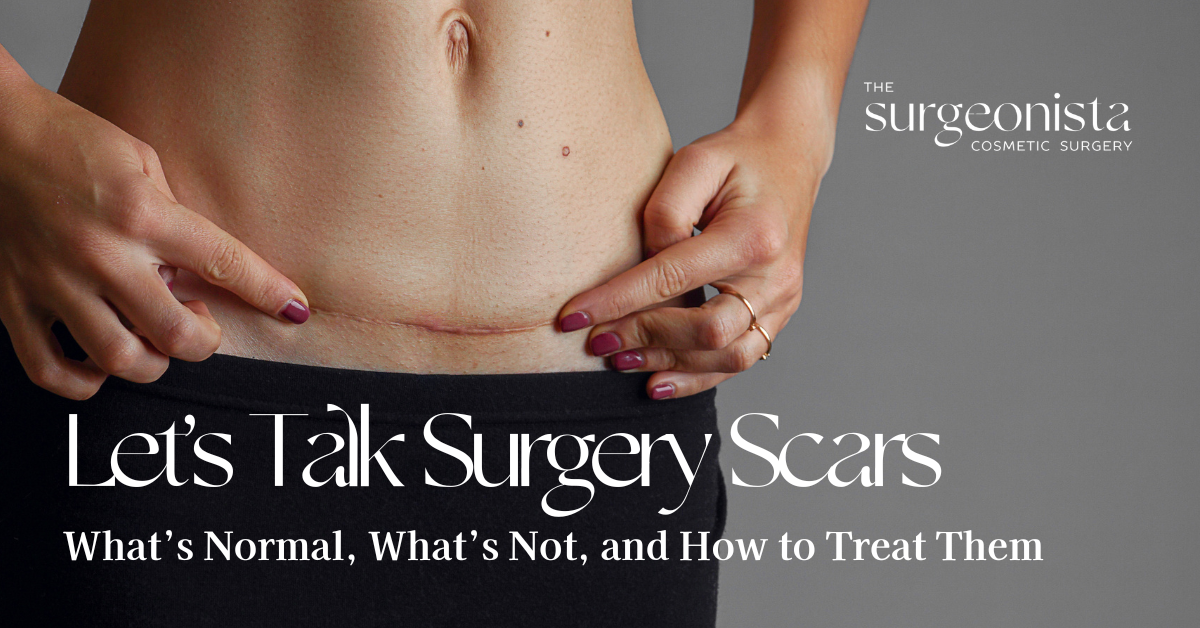By Dr. Gina Maccarone, MD, FACS, FAACS

Scars are a natural part of the healing process. Anytime the skin is cut, whether from an accident, a C-section, or cosmetic surgery, the body repairs itself by building new collagen fibers. It’s an incredible process, but it doesn’t always leave the skin looking exactly the same as before. For some patients, scars soften and fade beautifully over time. For others, they can remain raised, firm, or more visible. Understanding what’s normal, what’s not, and how to care for your scars is an important part of feeling confident in your results.
What to Expect With Surgical Scars
When it comes to cosmetic surgery, scars are one of the first concerns patients share in consultation. It’s natural to wonder what those incisions will look like as they heal. My approach is always to place scars as discreetly as possible, tucked into natural creases, hidden beneath undergarment lines, or blended along the hairline. But here’s the truth I always share: if you’re having surgery, you will have a scar. What matters most is how it heals, how visible it becomes, and how you feel about your results.
In the early weeks, scars often look pink or red and may feel firm. That’s normal. Over the following months, they gradually soften, flatten, and fade. Most continue to improve for 12–18 months. While no treatment can erase a scar entirely, there are many effective strategies to support beautiful healing.
Tips to Support Healing at Home
-
- Protect from the sun: UV exposure can darken new scars and make them more noticeable. As soon as you’re cleared, apply a broad-spectrum sunscreen and wear protective clothing.
- Keep the area moisturized: Dry scars tend to look more visible. Using silicone sheets or gels, as well as gentle moisturizers like Vaseline or Aquaphor, can help keep the skin supple and support healing.
- Don’t pick or scratch: It’s tempting, but pulling at scabs or scratching can disrupt healing and worsen the final scar. Patience is your best tool.
- Consider gentle massage: Once your surgeon clears you, massaging the scar for a few minutes a day can help soften firm tissue and improve flexibility.
Support Healing Through Recovery Habits
Healing isn’t just about what you put on your scars. It’s about how you support your body as a whole. Protein is essential for recovery, so I encourage patients to focus on a high-protein diet (around 100 grams daily) during the healing process. For scar care, silicone strips are a favorite among patients once incisions have closed, since they’re easy to use and highly effective. Sleep positioning is also important: while it may feel awkward at first, resting on your back with your head elevated helps minimize swelling and speeds recovery. Whatever setup makes this easier, extra pillows, a wedge, or an adjustable bed, will make a noticeable difference.
Reframing the Way You See Scars
One of the most important things I remind my patients is this: scars are not a sign that something went wrong. They’re proof that your body is healing. With time and the right care, scars often fade into something far less noticeable, and for many patients, they even become a quiet reminder of strength and transformation.
At the end of the day, the goal of cosmetic surgery is harmony. My role is to create results that look natural and aligned with your vision, while guiding you through every stage of recovery, including scar care. Scars are part of your story, but they don’t define it. With the right plan, they can become less of a concern and more a symbol of the empowering changes you’ve chosen for yourself.
Xo,
Dr. G
